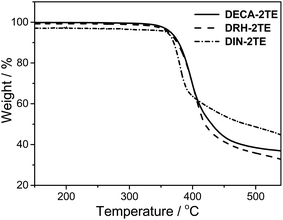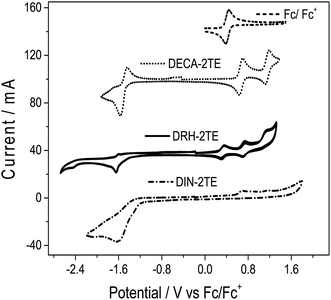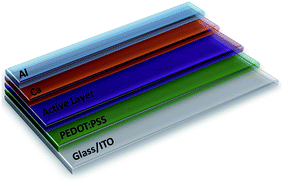Acceptor–donor–acceptor small molecules based on derivatives of 3,4-ethylenedioxythiophene for solution processed organic solar cells†
B. Y. Antwiab,
R. G. D. Taylorb,
J. Cameronb,
R. B. Owoarea,
R. Kingsford-Adaboh*a and
P. J. Skabara*b
aDepartment of Chemistry, University of Ghana, Legon, Accra, Ghana. E-mail: rkingsford-adaboh@ug.edu.gh
bWestCHEM, Department of Pure and Applied Chemistry, University of Strathclyde, 295 Cathedral Street, Glasgow, G1 1XL, United Kingdom. E-mail: peter.skabara@strath.ac.uk
First published on 10th October 2016
Abstract
Three simple semiconducting acceptor–donor–acceptor (A–D–A) small molecules based on an electron-rich (3,4-ethylenedioxythiophene) EDOT central core have been synthesised (DIN-2TE, DRH-2TE, DECA-2TE) and characterised. Organic photovoltaic (OPV) devices incorporating these materials have been prepared and evaluated. The physical properties of the molecules were characterised by TGA, DSC, UV/vis spectroscopy and cyclic voltammetry. The optical HOMO–LUMO energy gaps of the molecules in the solid state were in the range 1.57–1.82 eV, and in solution 1.88–2.04 eV. Electrochemical HOMO–LUMO energy gaps determined by cyclic voltammetry were found to be in the range 1.97–2.31 eV. The addition of 1% 1,8-diiodooctane (DIO) to photoactive blends of the A–D–A molecules and PC71BM more than doubled the power conversion efficiency (PCE) in the case of DRH-2TE:PC71BM devices to 1.36%.
Introduction
The use of organic materials as photoactive components in solar cells is of great interest1 due to their flexibility, ease of processing, large area applicability, tunability and the availability of raw materials,2–4 all of which are attributes that make them favourable compared to traditional silicon based devices. Recently, the use of small molecule, rather than polymeric, organic donors has gained attention due to their added advantages of well-defined molecular structure, low batch-to-batch variation5,6 and high open-circuit voltages (Voc).7 This has led to some impressively high PCEs for the top performing small molecule OPV devices (9.95%),8 approaching the records of polymeric devices (11.5%).1,9 However, many of these top performing materials have complex structures with multi-step syntheses which result in a high cost and low overall yield. As Roncali et al.10 recently remarked, ‘small is beautiful’ and truly small, simple organic donor molecules that have a simplistic and scalable synthesis5,11 should not be overlooked, even if their PCEs are lower than their more complex counterparts. Such materials are not only of interest as outright donors for OPV, but also as additives in ternary blend devices, which often exhibit enhanced PCE over their binary analogues.12,13In an effort to tune the properties of organic donor materials, several push–pull type structures have been explored where the conjugated backbone consists of alternating donor (D) and acceptor (A) units. This is most prevalent in D/A copolymers,14–16 but many small molecule architectures with D–A–D,17–20 A–D–A,21 D1–A–D2–A–D1,22 A′(D′AD)2,23 and D–A–D–π–D–A–D24 motifs (where π represents a conjugated linker) have also been investigated. Of these, the A–D–A architecture is particularly attractive due to the high device performances achieved8,25–27 and also because their synthesis is straightforward. In these molecules, alkyl cyanoacetate, rhodanine, indanedione and dicyanovinyl moieties27–34 are found to be efficient electron-acceptor groups, whilst typical donor components are: thiophene, benzodithiophene, dithienosilole, silafluorene, fluorene and carbazole.21 However, use of the strongly electron donating unit 3,4-ethylenedioxythiophene (EDOT) in A–D–A small molecule OPV devices has little precedent in the literature10,35 even though it has been commonly studied in other small molecule D/A architectures10,36,37 and polymeric devices.38–42 The ability of EDOT to induce planarity through non-covalent O⋯S interactions with neighbouring donor units increases the backbone rigidity and effective conjugation, which in turn narrows the HOMO–LUMO energy gap.43,44 This makes EDOT an attractive donor in the design of conjugated A–D–A small molecules for OPVs.
Herein, we report the first examples of A–D–A small molecules designed to utilise the planarising effect of EDOT in combination with acceptor units 1,3-indanedione, 3-ethylrhodanine and ethyl cyanoacetate. The molecules were synthesised through a simple synthetic strategy utilising C–H activation to couple EDOT to 5-bromo-4-hexylthiophene-2-carbaldehyde to give 2TE, which then underwent subsequent Knoevenagel condensations with methylene-containing acceptor units (Scheme 1). The resultant materials (DIN-2TE, DRH-2TE and DECA-2TE) showed good potential as electron donors, with LUMO energy levels suitable to work with that of [6,6]-phenyl C71 butyric acid methyl ester (PC71BM, −4.13 eV)45 for efficient exciton dissociation. The device performances were optimised by varying the D/A weight ratio, applying various thermal annealing temperatures and changing the volume ratio of DIO additive.
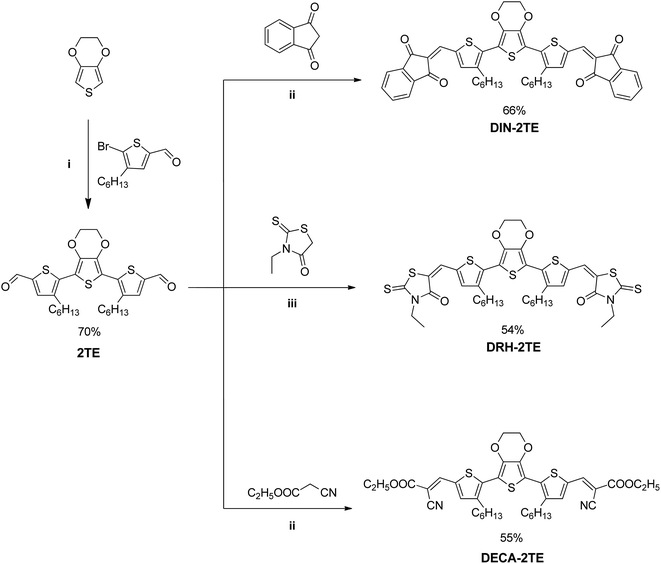 | ||
| Scheme 1 Reagents and conditions: (i) Cs2CO3, pivalic acid, Pd(OAc)2, PCy3·HBF4, DMF, 110 °C, 16 h; (ii) NEt3, CHCl3, reflux, 16 h; (iii) piperidine, CHCl3, reflux, 16 h. | ||
Results and discussion
Thermal properties
The thermal behaviour of DIN-2TE, DRH-2TE and DECA-2TE was explored by differential scanning calorimetry (DSC) and thermogravimetric analysis (TGA). The melting points determined by DSC of DECA-2TE, DRH-2TE and DIN-2TE were 236 °C, 249 °C and 335 °C, respectively (detailed plots in ESI†). TGA analysis (Fig. 1) shows that the molecules have good thermal stability with 5% weight loss temperatures (Td) all above 350 °C (Table 1).| Compound | Optical measurements | Electrochemical measurements | Td (°C) | ||||||
|---|---|---|---|---|---|---|---|---|---|
| Solution | Film | ||||||||
| λmax (nm) | Egapa (eV) | ε (L mol−1 cm−1) | λmax (nm) | Egapa (eV) | HOMOb (eV) | LUMOb (eV) | Egc (eV) | ||
| a Solution and solid state optical HOMO–LUMO gaps were calculated from the onset of the longest wavelength absorption peak using E = hc/λ and converting to eV.b HOMO and LUMO levels were calculated in reference to the Fc/Fc+ redox couple: EHOMO(LUMO) = (−4.80 − Eox(red)onset).c Electrochemical HOMO–LUMO gap = EHOMO − ELUMO. | |||||||||
| DIN-2TE | 570 | 1.88 | 7.3 × 104 | 592 | 1.57 | −5.49 | −3.18 | 2.31 | 360 |
| DRH-2TE | 545 | 1.93 | 5.2 × 104 | 550 | 1.71 | −5.13 | −3.16 | 1.97 | 362 |
| DECA-2TE | 510 | 2.08 | 4.0 × 105 | 513 | 1.82 | −5.46 | −3.30 | 2.16 | 363 |
Optical and electrochemical properties
All three A–D–A molecules showed strong absorption from 400–600 nm, extending up to 700 nm for DIN-2TE, arising from electronic π–π* transitions resulting in narrow HOMO–LUMO energy gaps (Fig. 2 and Table 1). DIN-2TE, DRH-2TE and DECA-2TE showed a λmax of 570 nm, 545 nm and 510 nm, respectively. DECA-2TE showed the strongest absorption in the visible region with an extinction coefficient of 4.0 × 105 L mol−1 cm−1. Broader absorption peaks observed in the solid state spectra (Fig. 2b), compared to the solution state spectra (Fig. 2a), led to a red-shifted absorbance which may be due to strong aggregation as well as rigid and planar backbones of the molecules in the solid state. This is in agreement with previous studies of molecules containing the same acceptor groups.45 The optical HOMO–LUMO energy gaps, estimated from the lowest energy onset of the longest wavelength absorption band in both solution and thin film, are outlined in Table 1. The HOMO–LUMO energy gaps for all compounds narrowed in the solid state compared to solution. DIN-2TE showed the lowest energy gap (1.57 eV) in the solid state, followed by DRH-2TE (1.71 eV) and DECA-2TE (1.82 eV).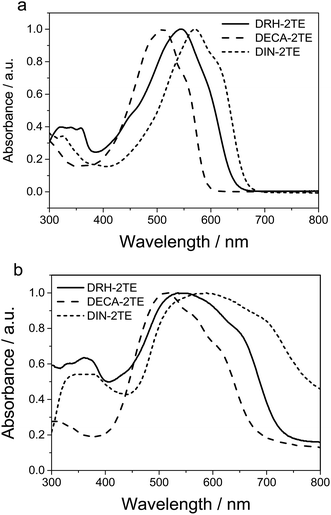 | ||
| Fig. 2 Normalised absorption spectra of DIN-2TE, DRH-2TE, and DECA-2TE (a) in chloroform solution (10−5 M) and (b) drop cast film on quartz glass. | ||
Cyclic voltammograms of DIN-2TE, DRH-2TE and DECA-2TE are shown in Fig. 3. DIN-2TE showed two irreversible oxidation waves and one irreversible reduction wave with peak potentials at +0.69 V, +1.16 V and −1.62 V, respectively. DRH-2TE showed two reversible oxidation processes at half-wave potentials of +0.33 V and +0.72 V, as well as an irreversible oxidation and reduction at +1.14 V and −1.64 V. Two reversible oxidation waves and one quasi-reversible reduction wave were found for DECA-2TE at half-wave potentials of +0.66 V, +1.15 V and −1.50 V respectively. We attribute the oxidation potentials to the electron-rich EDOT central donor and the reduction potentials to the electron deficient acceptor units. Therefore, an increasing order of acceptor electron withdrawing strength shows DRH < DIN < DECA, resulting in LUMO energy levels of −3.16, −3.18 and −3.30 eV for DRH-2TE, DIN-2TE and DECA-2TE respectively (Table 1). The HOMO energy levels of DECA-2TE and DIN-2TE show little variation (−5.49 and −5.46 eV respectively), however a shallower HOMO energy level of DRH-2TE (−5.13 eV) results in a narrower electrochemical HOMO–LUMO energy gap of (1.97 eV) compared to DECA-2TE and DIN-2TE (2.16 and 2.31 eV respectively).
Organic photovoltaic devices
OPV device performances of the A–D–A small molecules were investigated using the bulk-heterojunction architecture with indium tin oxide (ITO) and calcium as the electrodes and poly(3,4-ethylenedioxythiophene):polystyrene sulfonate (PEDOT:PSS) as a hole transport layer, with a device structure of glass/ITO/PEDOT:PSS/photoactive layer/Ca (40 nm)/Al (40 nm) (Fig. 4). The photoactive layer was processed from a chloroform solution of each small molecule donor and [6,6]-phenyl C71 butyric acid methyl ester (PC71BM) acceptor. However, unexpected limited solubility of DIN-2TE led to poor film formation, such that devices fabricated using this donor gave no electrical response. The greater solubility of DRH-2TE and DECA-2TE allowed for device fabrication and the study of varying donor/acceptor (D/A) weight ratios, annealing temperatures and the use of 1,8-diiodooctane (DIO) as an additive for DRH-2TE:PC71BM and DECA-2TE:PC71BM devices. The use of DIO in OPV devices often leads to an increased performance which has been attributed to the selective solubilising of the fullerene acceptor in the DIO. This improves intermixing between the donor and acceptor causing the formation of long, narrow donor-rich and acceptor-rich domains, which subsequently leads to an improved short-circuit current (Jsc).46,47 Averaged optimised device performances are shown in Table 2.| Photoactive blend (weight ratio) | Jsc (mA cm−2) | Voc (V) | FF | PCE (%) |
|---|---|---|---|---|
| a 60 °C annealing temperature for 20 min.b 90 °C annealing temperature for 20 min.c 1% diiodooctane. | ||||
DRH-2TE![[thin space (1/6-em)]](https://www.rsc.org/images/entities/char_2009.gif) : :![[thin space (1/6-em)]](https://www.rsc.org/images/entities/char_2009.gif) PC71BM (1 PC71BM (1![[thin space (1/6-em)]](https://www.rsc.org/images/entities/char_2009.gif) : :![[thin space (1/6-em)]](https://www.rsc.org/images/entities/char_2009.gif) 3)a 3)a |
3.04 | 0.64 | 0.30 | 0.63 |
DRH-2TE![[thin space (1/6-em)]](https://www.rsc.org/images/entities/char_2009.gif) : :![[thin space (1/6-em)]](https://www.rsc.org/images/entities/char_2009.gif) PC71BM (1 PC71BM (1![[thin space (1/6-em)]](https://www.rsc.org/images/entities/char_2009.gif) : :![[thin space (1/6-em)]](https://www.rsc.org/images/entities/char_2009.gif) 3)a,c 3)a,c |
5.60 | 0.68 | 0.35 | 1.36 |
DECA-2TE![[thin space (1/6-em)]](https://www.rsc.org/images/entities/char_2009.gif) : :![[thin space (1/6-em)]](https://www.rsc.org/images/entities/char_2009.gif) PC71BM (1 PC71BM (1![[thin space (1/6-em)]](https://www.rsc.org/images/entities/char_2009.gif) : :![[thin space (1/6-em)]](https://www.rsc.org/images/entities/char_2009.gif) 4)b 4)b |
2.96 | 0.85 | 0.41 | 1.03 |
DECA-2TE![[thin space (1/6-em)]](https://www.rsc.org/images/entities/char_2009.gif) : :![[thin space (1/6-em)]](https://www.rsc.org/images/entities/char_2009.gif) PC71BM (1 PC71BM (1![[thin space (1/6-em)]](https://www.rsc.org/images/entities/char_2009.gif) : :![[thin space (1/6-em)]](https://www.rsc.org/images/entities/char_2009.gif) 4)b,c 4)b,c |
2.99 | 0.90 | 0.39 | 1.05 |
DRH-2TE![[thin space (1/6-em)]](https://www.rsc.org/images/entities/char_2009.gif) :
:![[thin space (1/6-em)]](https://www.rsc.org/images/entities/char_2009.gif) PC71BM devices at an optimum D/A weight ratio (1
PC71BM devices at an optimum D/A weight ratio (1![[thin space (1/6-em)]](https://www.rsc.org/images/entities/char_2009.gif) :
:![[thin space (1/6-em)]](https://www.rsc.org/images/entities/char_2009.gif) 3) and annealing temperature (90 °C) gave a power conversion efficiency (PCE) of 0.63%, with an open-circuit voltage (Voc) of 0.64 V, low fill factor (FF) (0.30) and Jsc of 3.04 mA cm−2. Optimised DECA-2TE:PC71BM devices demonstrated a better PCE of 1.03% at a D/A weight ratio of 1
3) and annealing temperature (90 °C) gave a power conversion efficiency (PCE) of 0.63%, with an open-circuit voltage (Voc) of 0.64 V, low fill factor (FF) (0.30) and Jsc of 3.04 mA cm−2. Optimised DECA-2TE:PC71BM devices demonstrated a better PCE of 1.03% at a D/A weight ratio of 1![[thin space (1/6-em)]](https://www.rsc.org/images/entities/char_2009.gif) :
:![[thin space (1/6-em)]](https://www.rsc.org/images/entities/char_2009.gif) 4 and annealing temperature of 60 °C, attributable to a superior Voc (0.85 V) and FF (0.41), compared to DRH-2TE:PC71BM devices. Diverse PCEs of A–D–A small molecules can be accredited to the differing Voc values which are related to the difference between the donor HOMO and acceptor LUMO energy levels.45 Therefore, the deep HOMO level (−5.46 eV) of DECA-2TE resulted in a higher Voc (0.85 V) in comparison to the shallower HOMO level of DRH-2TE (−5.13 eV) and lower Voc (0.64 V). The LUMO level of the donor molecules also contributed to varied device performance, consistent with predictions made by Scharber et al.48 Therefore, a donor with an improved Voc due to a deeper HOMO energy level, combined with a LUMO energy level close to that of PC71BM (for efficient charge separation), will lead to higher Jsc and enhanced PCE.
4 and annealing temperature of 60 °C, attributable to a superior Voc (0.85 V) and FF (0.41), compared to DRH-2TE:PC71BM devices. Diverse PCEs of A–D–A small molecules can be accredited to the differing Voc values which are related to the difference between the donor HOMO and acceptor LUMO energy levels.45 Therefore, the deep HOMO level (−5.46 eV) of DECA-2TE resulted in a higher Voc (0.85 V) in comparison to the shallower HOMO level of DRH-2TE (−5.13 eV) and lower Voc (0.64 V). The LUMO level of the donor molecules also contributed to varied device performance, consistent with predictions made by Scharber et al.48 Therefore, a donor with an improved Voc due to a deeper HOMO energy level, combined with a LUMO energy level close to that of PC71BM (for efficient charge separation), will lead to higher Jsc and enhanced PCE.
Accordingly, attempts to improve Jsc by optimising device morphology were pursued through the use of DIO as an additive in the D/A blend at different volume ratios. As shown in Table 2, the efficiency of both DRH-2TE:PC71BM and DECA-2TE:PC71BM devices improved through the addition of 1% DIO. Other ratios of DIO were tested (see ESI†), but did not improve performance. PCEs of DECA-2TE![[thin space (1/6-em)]](https://www.rsc.org/images/entities/char_2009.gif) :
:![[thin space (1/6-em)]](https://www.rsc.org/images/entities/char_2009.gif) PC71BM (1
PC71BM (1![[thin space (1/6-em)]](https://www.rsc.org/images/entities/char_2009.gif) :
:![[thin space (1/6-em)]](https://www.rsc.org/images/entities/char_2009.gif) 4 weight ratio) devices increased slightly from 1.03% to 1.05%, but DRH-2TE
4 weight ratio) devices increased slightly from 1.03% to 1.05%, but DRH-2TE![[thin space (1/6-em)]](https://www.rsc.org/images/entities/char_2009.gif) :
:![[thin space (1/6-em)]](https://www.rsc.org/images/entities/char_2009.gif) PC71BM (1
PC71BM (1![[thin space (1/6-em)]](https://www.rsc.org/images/entities/char_2009.gif) :
:![[thin space (1/6-em)]](https://www.rsc.org/images/entities/char_2009.gif) 3 weight ratio) PCEs more than doubled (0.63% to 1.36%). This can be attributed to a large improvement in Jsc (3.04 vs. 5.60 mA cm−2). Fig. 5 shows the J–V curves of A–D–A small molecule:PC71BM devices with and without 1% DIO.
3 weight ratio) PCEs more than doubled (0.63% to 1.36%). This can be attributed to a large improvement in Jsc (3.04 vs. 5.60 mA cm−2). Fig. 5 shows the J–V curves of A–D–A small molecule:PC71BM devices with and without 1% DIO.
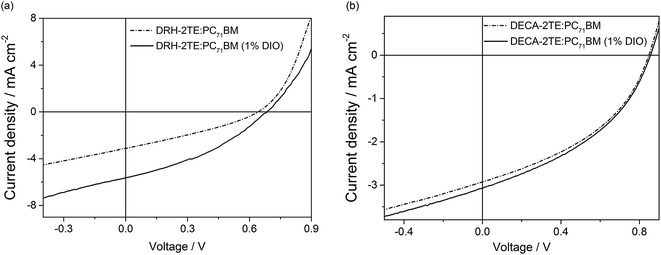 | ||
| Fig. 5 Current–voltage curves of optimised (a) DRH-2TE:PC71BM and (b) DECA-2TE:PC71BM bulk-heterojunction devices with and without 1% DIO additive under AM 1.5G illumination. | ||
Morphological study
Atomic force microscopy (AFM) was used to investigate the morphology of the enhanced device performance for optimised DRH-2TE![[thin space (1/6-em)]](https://www.rsc.org/images/entities/char_2009.gif) :
:![[thin space (1/6-em)]](https://www.rsc.org/images/entities/char_2009.gif) PC71BM (1
PC71BM (1![[thin space (1/6-em)]](https://www.rsc.org/images/entities/char_2009.gif) :
:![[thin space (1/6-em)]](https://www.rsc.org/images/entities/char_2009.gif) 3) (90 °C) and DECA-2TE
3) (90 °C) and DECA-2TE![[thin space (1/6-em)]](https://www.rsc.org/images/entities/char_2009.gif) :
:![[thin space (1/6-em)]](https://www.rsc.org/images/entities/char_2009.gif) PC71BM (1
PC71BM (1![[thin space (1/6-em)]](https://www.rsc.org/images/entities/char_2009.gif) :
:![[thin space (1/6-em)]](https://www.rsc.org/images/entities/char_2009.gif) 4) (60 °C) devices, with and without 1% DIO as shown in Fig. 6 and 7, respectively.
4) (60 °C) devices, with and without 1% DIO as shown in Fig. 6 and 7, respectively.
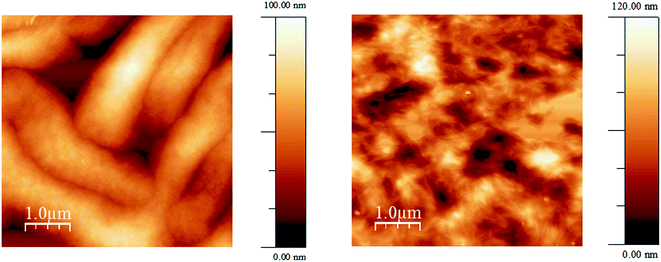 | ||
Fig. 6 Tapping mode AFM height images of the best performing DRH-2TE:PC71BM device without DIO (left) and with 1% DIO (right). 1![[thin space (1/6-em)]](https://www.rsc.org/images/entities/char_2009.gif) : :![[thin space (1/6-em)]](https://www.rsc.org/images/entities/char_2009.gif) 3 D/A weight ratio, annealed at 90 °C. 3 D/A weight ratio, annealed at 90 °C. | ||
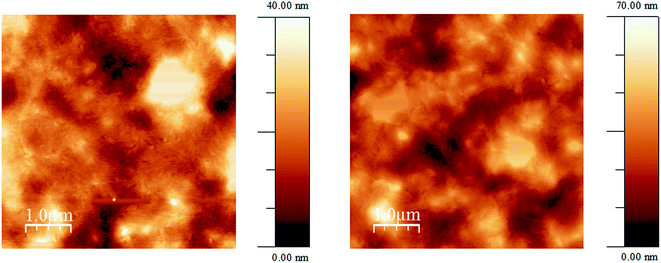 | ||
Fig. 7 Tapping mode AFM height images of the best performing DECA-2TE:PC71BM device without DIO (left) and with 1% DIO (right). 1![[thin space (1/6-em)]](https://www.rsc.org/images/entities/char_2009.gif) : :![[thin space (1/6-em)]](https://www.rsc.org/images/entities/char_2009.gif) 4 D/A weight ratio, annealed at 60 °C. 4 D/A weight ratio, annealed at 60 °C. | ||
Devices containing DRH-2TE![[thin space (1/6-em)]](https://www.rsc.org/images/entities/char_2009.gif) :
:![[thin space (1/6-em)]](https://www.rsc.org/images/entities/char_2009.gif) PC71BM (1
PC71BM (1![[thin space (1/6-em)]](https://www.rsc.org/images/entities/char_2009.gif) :
:![[thin space (1/6-em)]](https://www.rsc.org/images/entities/char_2009.gif) 3) showed a smoother surface morphology (RMS roughness 18.3 nm) with 1% DIO compared to those without (RMS roughness 44.9 nm) (Fig. 6), indicating reduced D/A domain sizes giving rise to a more uniform film and improved device performance.49 Accordingly, the smaller domains of interpenetrating D/A aggregates in the DRH-2TE:PC71BM devices with 1% DIO (compared to the larger aggregates in devices without DIO, Fig. 6) resulted in enhanced charge separation, leading to an improved Jsc (3.04 vs. 5.60 mA cm−2) and PCE (0.63 vs. 1.36%).
3) showed a smoother surface morphology (RMS roughness 18.3 nm) with 1% DIO compared to those without (RMS roughness 44.9 nm) (Fig. 6), indicating reduced D/A domain sizes giving rise to a more uniform film and improved device performance.49 Accordingly, the smaller domains of interpenetrating D/A aggregates in the DRH-2TE:PC71BM devices with 1% DIO (compared to the larger aggregates in devices without DIO, Fig. 6) resulted in enhanced charge separation, leading to an improved Jsc (3.04 vs. 5.60 mA cm−2) and PCE (0.63 vs. 1.36%).
In contrast, the surface morphologies of DECA-2TE with and without 1% DIO look similar (Fig. 7), suggesting that the DIO did not have any significant effect on the micromorphology, and thus gave no significant improvement in Jsc or PCE. Fig. 7 shows that narrow fibre-like domains which are favourable for charge transport are already present without the addition of DIO, demonstrating that DECA-2TE/PC71BM blends have the ability to aggregate into optimal domain sizes without the need of an additive or co-solvent. This effect has been reported previously50 and attributed to strong aggregation of the donor, resulting in no morphological change through DIO addition. Given that DIO has been shown to cause decreased photostability in the active layer of OPV devices,51 there is an advantage in using donor materials such as DECA-2TE, which do not require use of a co-solvent to form a suitable morphology.
Summary
Three simple semiconducting A–D–A small molecule donors (DIN-2TE, DRH-2TE and DECA-2TE) have been synthesised and fully characterised. DIN-2TE demonstrated the lowest optical HOMO–LUMO energy gap in both solution and solid state (1.88 and 1.57 eV, respectively). A shallower HOMO (−5.13 eV) of DRH-2TE contributed to a narrower electrochemical HOMO–LUMO energy gap (1.97 eV) compared to DIN-2TE (2.31 eV) and DECA-2TE (2.16 eV). Working OPV devices were realised for DRH-2TE:PC71BM and DECA-2TE:PC71BM, with PCEs for DRH-2TE-based devices more than doubling with the addition of 1% DIO (0.63 vs. 1.36%). Devices containing DECA-2TE showed very little improvement with the addition of 1% DIO, which can be attributed to the optimal film morphology achieved without the addition of DIO. These results demonstrate that the choice of acceptor unit in A–D–A type molecules has an impact on more than just the optical and electrochemical properties of the resultant material. As such, careful consideration of aggregation, solubility and the use of additives should be employed when designing such materials and their device structures.Acknowledgements
PJS thanks the Royal Society for a Wolfson Research Merit Award. BYA is grateful for a Leverhulme-Royal Society Africa Award and a University of Ghana-Carnegie Next Generation of Academics Award. RGDT thanks the EPSRC for funding (EP/L012200/1). Supporting data are accessible from http://dx.doi.org/10.15129/baac5af3-4d02-4c1d-80ff-99e8eb42ce85.References
- National Renewable Energy Laboratory, http://www.nrel.gov/ncpv/images/efficiency_chart.jpg, 2016.
- R. Po and J. Roncali, J. Mater. Chem. C, 2016, 4, 3677–3685 RSC.
- M. Shaker, J.-H. Lee, C. K. Trinh, W. Kim, K. Lee and J.-S. Lee, RSC Adv., 2015, 5, 66005–66012 RSC.
- Q. An, F. Zhang, J. Zhang and W. Tang, Energy Environ. Sci., 2016, 9, 281–322 Search PubMed.
- H. Qin, L. Li, F. Guo, S. Su, J. Peng, Y. Cao and X. Peng, Energy Environ. Sci., 2014, 7, 1397 CAS.
- G. D. Sharma, J. A. Mikroyannidis, R. Kurchania and K. R. J. Thomas, J. Mater. Chem., 2012, 22, 13986 RSC.
- B. Walker, C. Kim and T. Q. Nguyen, Chem. Mater., 2011, 23, 470–482 CrossRef CAS.
- Q. Zhang, B. Kan, F. Liu, G. Long, X. Wan, X. Chen, Y. Zuo, W. Ni, H. Zhang, M. Li, Z. Hu, F. Huang, Y. Cao, Z. Liang, M. Zhang, T. P. Russell and Y. Chen, Nat. Photonics, 2014, 9, 35–41 CrossRef.
- J. Zhao, Y. Li, G. Yang, K. Jiang, H. Lin, H. Ade, W. Ma and H. Yan, Nature Energy, 2016, 1, 15027 CrossRef.
- J. Roncali, P. Leriche and P. Blanchard, Adv. Mater., 2014, 26, 3821–3838 CrossRef CAS PubMed.
- D. Demeter, S. Mohamed, A. Diac, I. Grosu and J. Roncali, ChemSusChem, 2014, 7, 1046–1050 CrossRef CAS PubMed.
- L. Ye, H. Xu, H. Yu, W. Xu, H. Li, H. Wang, N. Zhao and J. Xu, J. Phys. Chem. C, 2014, 118, 20094–20099 CAS.
- P. Cheng and X. Zhan, Mater. Horiz., 2015, 2, 462–485 RSC.
- W. Li, L. Yang, J. R. Tumbleston, L. Yan, H. Ade and W. You, Adv. Mater., 2014, 4456–4462 CrossRef CAS PubMed.
- J. W. Jung, J. W. Jo, E. H. Jung and W. H. Jo, Org. Electron., 2016, 31, 149–170 CrossRef CAS.
- Z. Zhang and J. Wang, J. Mater. Chem., 2012, 22, 4178 RSC.
- D. Deng, Y. Yang, J. Zhang, C. He, M. Zhang, Z. G. Zhang, Z. Zhang and Y. Li, Org. Electron., 2011, 12, 614–622 CrossRef CAS.
- A. Yassin, P. Leriche, M. Allain and J. Roncali, New J. Chem., 2013, 37, 502–507 RSC.
- J. Zhang, C. He, Z. Zhang and D. Deng, Philos. Trans. R. Soc., A, 2014, 372, 20130009 CrossRef PubMed.
- A. M. Coclite, R. M. Howden, D. C. Borrelli, C. D. Petruczok, R. Yang, J. L. Yagüe, A. Ugur, N. Chen, S. Lee, W. J. Jo, A. Liu, X. Wang and K. K. Gleason, Adv. Mater., 2013, 25, 5392–5423 CrossRef CAS PubMed.
- W. Ni, X. Wan, M. Li, Y. Wang, Y. Chen and W. Ni, Chem. Commun., 2015, 51, 4936–4950 RSC.
- C. V. Kumar, L. Cabau, E. N. Koukaras, G. D. Sharma and E. Palomares, Org. Electron., 2015, 26, 36–47 CrossRef CAS.
- M. Shaker, J. Lee, C. K. Trinh, W. Kim, K. Lee and J. Lee, RSC Adv., 2015, 5, 66005–66012 RSC.
- Y. Patil, R. Misra, A. Sharma and G. D. Sharma, Phys. Chem. Chem. Phys., 2016, 18, 16950–16957 RSC.
- J. Zhou, Y. Zuo, X. Wan, G. Long, Q. Zhang, W. Ni, Y. Liu, Z. Li, G. He, C. Li, B. Kan, M. Li and Y. Chen, J. Am. Chem. Soc., 2013, 135, 8484–8487 CrossRef CAS PubMed.
- M. Cheng, C. Chen, X. Yang, J. Huang, F. Zhang, B. Xu and L. Sun, Chem. Mater., 2015, 27, 1808–1814 CrossRef CAS.
- G. He, Z. Li, X. Wan, J. Zhou, G. Long, S. Zhang, M. Zhang and Y. Chen, J. Mater. Chem. A, 2013, 1, 1801–1809 CAS.
- G. He, X. Wan, Z. Li, Q. Zhang, G. Long, Y. Liu, Y. Hou, M. Zhang and Y. Chen, J. Mater. Chem. C, 2014, 2, 1337–1345 RSC.
- Y. Zhou, M. Xiao, D. Liu, Z. Du, W. Chen, D. Ouyang, L. Han, X. Wan and R. Yang, Org. Electron., 2015, 17, 355–363 CrossRef CAS.
- Y. Kim, C. E. Song, S. Moon, E. Lim, V. A. Online, Y. Kim, C. E. Song, S. Moon and E. Lim, Chem. Commun., 2014, 50, 8235–8238 RSC.
- R. Fitzner, E. Reinold, A. Mishra, E. Mena-Osteritz, P. Bäuerle, H. Ziehlke, C. Körner, K. Leo, M. Riede, M. Weil, O. Tsaryova, A. Weiß, C. Uhrich and M. Pfeiffer, Adv. Funct. Mater., 2011, 21, 897–910 CrossRef CAS.
- Z. Wang, Z. Li, J. Liu, J. Mei, K. Li, Y. Li and Q. Peng, ACS Appl. Mater. Interfaces, 2016, 8, 11639–11648 Search PubMed.
- Y. Lin, P. Cheng, Y. Liu, Q. Shi, W. Hu, Y. Li and X. Zhan, Org. Electron., 2012, 13, 673–680 CrossRef CAS.
- B. Kan, Q. Zhang, M. Li, X. Wan, W. Ni, G. Long, Y. Wang, X. Yang, H. Feng and Y. Chen, J. Am. Chem. Soc., 2014, 136, 15529–15532 CrossRef CAS PubMed.
- S. M. Tuladhar, M. Azzouzi, F. Delval, J. Yao, A. A. Y. Guilbert, T. Kirchartz, N. F. Montcada, R. Dominguez, F. Langa, E. Palomares and J. Nelson, ACS Energy Lett., 2016, 1, 302–308 CrossRef CAS.
- D. Demeter, T. Rousseau and J. Roncali, RSC Adv., 2013, 3, 704 RSC.
- A. Diac, D. Demeter, M. Allain, I. Grosu and J. Roncali, Chem.–Eur. J., 2015, 21, 1598–1608 CrossRef CAS PubMed.
- C. Wang, C. J. Mueller, E. Gann, A. C. Y. Liu, M. Thelakkat and C. R. McNeill, J. Mater. Chem. A, 2016, 4, 3477–3486 CAS.
- J. Roncali, P. Blanchard and P. Frere, J. Mater. Chem., 2005, 15, 1589–1610 RSC.
- N. I. Abdo, J. Ku, A. A. El-Shehawy, H.-S. Shim, J.-K. Min, A. A. El-Barbary, Y. H. Jang and J.-S. Lee, J. Mater. Chem. A, 2013, 1, 10306 CAS.
- A. M. Österholm, J. F. Ponder, J. A. Kerszulis and J. R. Reynolds, ACS Appl. Mater. Interfaces, 2016, 8, 13492–13498 Search PubMed.
- A. M. Österholm, D. E. Shen, A. L. Dyer and J. R. Reynolds, ACS Appl. Mater. Interfaces, 2013, 5, 13432–13440 Search PubMed.
- G. Conboy, H. Spencer, E. Angioni, A. Kanibolotsky, N. J. Findlay, S. Coles, C. Wilson, M. Pitak, C. Risko, V. Coropceanu, J. Bredas and P. Skabara, Mater. Horiz., 2016, 3, 333 RSC.
- H. Pang, P. J. Skabara, S. Gordeyev, J. J. W. Mcdouall, S. J. Coles and M. B. Hursthouse, Chem. Mater., 2007, 19, 301–307 CrossRef CAS.
- J. Sim, H. Lee, K. Song, S. Biswas, A. Sharma, G. D. Sharma and J. Ko, J. Mater. Chem. C, 2016, 4, 3508–3516 RSC.
- A. Zusan, B. Gieseking, M. Zerson, V. Dyakonov, R. Magerle and C. Deibel, Sci. Rep., 2015, 5, 8286 CrossRef CAS PubMed.
- G. J. Hedley, A. J. Ward, A. Alekseev, C. T. Howells, E. R. Martins, L. A. Serrano, G. Cooke, A. Ruseckas and I. D. W. Samuel, Nat. Commun., 2013, 4, 2867 Search PubMed.
- M. C. Scharber, D. Mühlbacher, M. Koppe, P. Denk, C. Waldauf, A. J. Heeger and C. J. Brabec, Adv. Mater., 2006, 18, 789–794 CrossRef CAS.
- Z. Wang, F. Zhang, L. Li, Q. An, J. Wang and J. Zhang, Appl. Surf. Sci., 2014, 305, 221–226 CrossRef CAS.
- M. Saito, I. Osaka, Y. Suzuki, K. Takimiya, T. Okabe, S. Ikeda and T. Asano, Sci. Rep., 2015, 5, 14202 CrossRef CAS PubMed.
- B. J. Tremolet De Villers, K. A. O'Hara, D. P. Ostrowski, P. H. Biddle, S. E. Shaheen, M. L. Chabinyc, D. C. Olson and N. Kopidakis, Chem. Mater., 2016, 28, 876–884 CrossRef CAS.
Footnote |
| † Electronic supplementary information (ESI) available: Synthesis and characterisation of all novel materials, DSC plots and additional OPV device data. See DOI: 10.1039/c6ra22897f |
| This journal is © The Royal Society of Chemistry 2016 |

